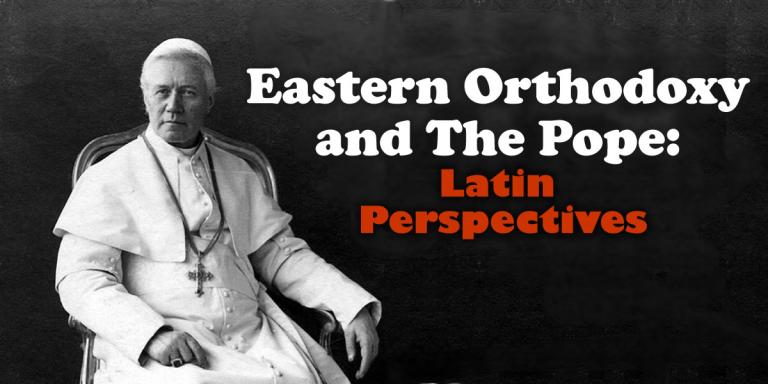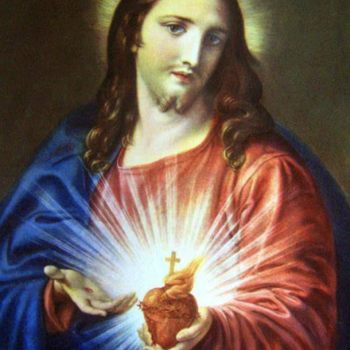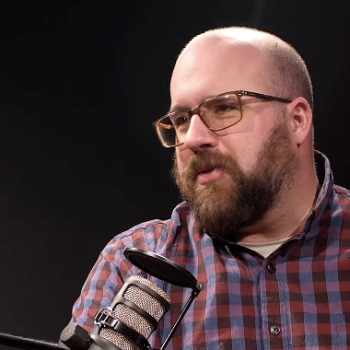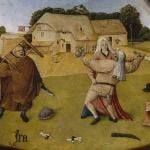This article is the third and final instalment in my series on reconciling the papacy between east and west. You can read the first post that offers and overview of the history of the papacy in relationship to the East here. You can read the second installment that goes over Eastern perspectives on paths to unity here. I hope you will leave any feedback you have on this project in the comments section below.
—————————————————————
The west has contributed significant theological reflection on their own perception of the papacy. Often this perspective was simply imposed upon the East. This resulted in much of the breakdown in dialog which has led to the impasse that dominates the current theological landscape. This attitude has shifted significantly in the past 50 years. Increasingly Catholics are forming their theology in consultation with Eastern perspectives. This article seeks to highlight some of the more significant efforts made by Catholics in this arena in recent years. Interestingly, as is noted by DeVille, one of the unifying perspectives made by theologians on the papacy is a deepening of the understanding of the patriarchal aspect of the role of Rome’s bishop.[1] The historical title of the Pope as patriarch of the West, although recently used less frequently, helps ground the office within the shared language of the East.[2]
Joseph Ratzinger
Joseph Ratzinger was one of the first theologians to explore the opportunity present in differentiating the role of “Patriarch of the West” from other papal offices. He believed that exploring the patriarchal office could help distinguish those tasks that the pope has, which are an expression of his universal petrine mission, and those which are particular to his administrative role in the western expression of the faith. He believed that the schism between east and west was precipitated by confusion between those two roles.[3] The magisterium had begun to see all aspects of the papal ministry as universal, when in fact many of them were expressions of the regional patriarchal ministry.
A patriarch was originally established in a region to reflect the distinct cultural and social realities of a given context. This is why they were fixed in epicenters of local power and influence. For example, it was originally the responsibility of the patriarch to guide the liturgical expressions within his region of particular administration. This allows the Patriarch to conform the liturgy to the genius of his particular context.[4]
As the assimilation of the roman patriarchate into the petrine office developed, the pope began to express his patriarchal responsibilities over a broader sphere, and the Church in the west became increasingly centralized.[5] Ratzinger believed this new authority, when imposed on the east in 1054 in, was an encroachment upon the patriarchal ministry of the East. He even goes so far as to argue that in the future there may need to be new patriarchates established in regions like Asia and Africa.[6] This theological perspective would prove to be increasingly influential at the turn of the century.[7] For example, Jean-Marie-René Tillard agrees with the assertion of Ratzinger that the offices of the pope cave become too confused and integrated, and proposes a scheme in which the Petrine primacy of his ministry is always expressed as one that seeks to honor the local and patriarchal functions of a given context in any expression it takes.[8]
Michael Magee:
Arguably the most substantial examination of this subject in recent years has been taken on by Michael Magee.[9] Magee seeks to formulate a catholic position that is rooted in the dogma of the church as much as it is in the historical accidents of history. He looks to the development of the Patriarchates of the East as a model that can help the West better understand the patriarchal aspect of the papal ministry. He believes that the East has better understood the organic need for both patriarchs, because the development of these offices has been linked less definitively to the assumption of apostolic preeminence through the petrine ministry. The eastern perspective on the patriarchate is fundamentally ecclesial in origin. As Magee states:
“The crucial difference between the eastern and western thinking on the primacy is to be traced to their respective starting points. Eastern ecclesiology has tended to begin with the episcopacy as such, finding in its collegial nature the imperative for the regulation of individual members by the collage as a whole, which in turn requires an authoritative spokesman. Western ecclesiology, and particularly Roman ecclesiology, on the other hand, has not arrived at an awareness of the need of such a process, but has held it as a given from the start, contained within the commission of Christ to Peter.“ [10]
Magee explores the genetic relationship of the Roman patriarchate to scripture, tradition and circumstance with a candid look at its history. The result is a significant foundation for Roman Catholic self-understanding of the distinctiveness of the patriarchal office of the pope. This understanding is articulated by Magee when he attempts to formulate a definition for the patriarchal office of Rome. He states:
The Patriarchal institution may be described as that ordering of the communion of the universal Church . . . by which each of the supra-local particular Churches (encompassing hierarchically ordered groupings of local Churches with their respective Bishops) is headed by a Protos (usually the Bishop of the principal See claiming an apostolic or otherwise long-standing and venerable foundation) enjoying an habitual administrative “primacy” within the particular Church, in union with the Bishops of the same particular Church, in union with whom the Bishops of the same particular Church exercise collegial stewardship of the complex of liturgical, canonical, theological and spiritual traditions that are formative of their believers’ faith.[11]
Magee concludes his work admitting that there is much work to be done. He has offered a conclusive analysis of the theological and historical pedigree of the papacy but does not offer a definitive path forward. This work is picked up a few years later in the work of Adam DeVille.
Adam A. J. DeVille
The recent work of the Eastern Catholic scholar, Adam A. J. DeVille, offers one of the first bold proposals for a way forward. His study on the papacy as it relates to East/West relations might easily be called the definitive contemporary work on the subject. His project offers a highly in depth examination of Orthodox perspectives on the Papacy, as well as a well-researched survey of Catholic thinking. He builds on the research of Ratzinger and Magee by offering a look at contemporary patriarchal structures in the East. He seeks to allay fears that a more strictly defined Latin patriarchate would diminish the power of the Roman governance, noting that there are many Orthodox who actually promote a strong centralized papacy in the Latin West.[12]
DeVille identifies four basic models in the east for structuring the office of the Patriarch. He believes that this diversity helps situate conversations about the Roman papacy within a context through which the Roman patriarchate can develop in a way that is consistent with its own identity and history . A Latin patriarchate will not be forced into conforming to the other patriarchates. The first model he identifies is the “very centralized” model, which is seen in Constantinople. He then identifies the to the “moderately centralized” model seen in Moscow, Alexandria and Bucharest, as well as the “decentralized” model of Sofia, and Antioch. Finally he identifies a “very decentralized” category seen in Armenia. This unprecedented study is valuable in helping to understand the truly local and organic particularity of patriarchal administration.[13]
Perhaps the boldest aspect of DeVille’s work is the attempt that he makes to plot a map toward union. He believes this would be done through a renewed patriarchate in the west and he offers concrete suggestions for implementation. He roots his effort in Eve Congar’s law that reform of the Church must be rooted in the tradition of the Church; rooting his suggestions first in tradition, and then making practical recommendations for modern modifications when necessary.[14]
DeVille offers four practical suggestions for how the Church might go about establishing a renewed Roman Patriarchate. First he argues for establishing Latin patriarchal structures. Secondly he argues for the establishment of a full synod in each patriarchate. Thirdly he argues for the need for there to be a permanent synod in the patriarchate as well. Finally he argues that there would need to be an ecumenical synod in which all the patriarchs could meet.
DeVille proposes that the establishment of regional patriarchates should follow the division of the continents. Therefore he proposes 6 new Roman Patriarchates. He believes that this system will help to balance the political pressure that can be imposed by ecclesial structures tied to closely with the boundaries of secular states. For each of these patriarchates, he recognizes the importance of a corresponding episcopal see. To determine which cities should ascend to this designation he proposes a creative solution. DeVille states:
“I would propose that one could extrapolate from the principal of apostolicity to argue that the appointment of a first bishop and the erection of the first diocese on a continent is sufficient to establish “apostolic” credentials for our purposes here.”[15]
Under this schema the see of Europe would be Rome. The See of Africa would therefore be Alexandria, and the see in Asia would be Jerusalem. Combining Australia with the South Pacific, he argues the see would be Sydney. In the Americas the See of North America would be Quebec, and the See of South America would be Santa Dimengo.
His second and third suggestions are the establishment of full and permanent synods in each patriarchate. The full synod would consist of all the diocesan bishops holding office in the patriarchal territory and the permanent synod would consist in the presidents of the episcopal conferences in the patriarchal territory together.[16] There would be a need for full and permanent synods to be established for the whole Latin Church as well.
While the first three suggestions are designed to be implemented only in the Latin Church, his final suggestion concerns the east as well. DeVille proposes an “Ecumenical Synod” where would be gathered, “all patriarchs, Eastern and Western, under the presidency of the pope, acting not with reference to the Latin Church, but for the good of the universal Church.”[17] DeVille says he was inspired by suggestions made in 1996 by Thomas Hopko about a similar structure. DeVille believes these Synods would only concern themselves with issues that concerned the whole Church, and would come decisions together about how best to address them. Given the limited scope of this mission Deville believes:
“Such synods would most likely be rare events given that patriarchs and their own synods would, in the overwhelming majority of cases, remain the autonomous appropriate bodies for resolving most issues.”[18]
DeVille’s bold suggestions has been applauded by Msgr. Michael Magee as a good starting place, although he does take issue with the evolution of the Latin Church into six distinct Patriarchates, believing the expansion of patriarchates requires a more organic development.[19]
Conclusions
There is a shared understanding between Catholicism and Orthodoxy of a certain primacy of Rome as a fact of history. Many Orthodox are willing to grant a primacy as was enjoyed in the first millennium, but believe that the papacy as it is currently expressed is in need of a significant diminishment or paring down, particularly in the area of universal jurisdiction. Some Orthodox even go so far as to desire or promote the primacy of Rome to be reestablished in their ecclesial life, believing that the Pope could heal disunity among their own communities. Toward this end, Catholics are increasingly willing to reexamine their own understanding of the Papal office, and DeVille has even suggested significant first steps, like a substantial reformation of the Latin Patriarchate. Although theologians like Hopko articulate there is still a long way to go before the Orthodox would be willing to accept the Pope, there is a mutual desire for ecclesial kenosis so that unity might be achieved.
This article is the third and final instalment in my series on reconciling the papacy between east and west. You can read the first post that offers and overview of the history of the papacy in relationship to the East here. You can read the second installment that goes over Eastern perspectives on paths to unity here. I hope you will leave any feedback you have on this project in the comments section below.
NOTES:
[1] DeVille, Orthodoxy and the Roman Papacy: Ut Unum Sint and the Prospects of East-West Unity, 47.
[2] In 2006 the pontifical yearbook, Annuario Pontificio. did not include this title. They stated that this decision was inspired because of a recognition that the West had become associated with contexts outside of its original geographic designation articulated in the Councils of Constantinople (381) and of Chalcedon (451). See: Pontifical Council for Promoting Christian Unity, “Communiqué Concernant La Suppression Du Titre Patriarche d’Occident,” The Vatican, March 22, 2006, http://www.vatican.va/roman_curia/pontifical_councils/chrstuni/general-docs/rc_pc_chrstuni_doc_20060322_patriarca-occidente_fr.html.
[3] Joseph Ratzinger, “Primacy and Episcopacy,” Theological Digest 26 (1971): 201–202.
[4] For more on this see: Michael Magee, The Patriarchal Institution in the Church: Ecclesiological Perspectives in the Light of the Second Vatican Council (Rome: Herder, 2006), 387–96.
[5] Ratzinger, “Primacy and Episcopacy,” 205–06.
[6]Ibid., 206.
[7] Adam DeVille identies a total of seventeen theologians since Ratzinger who have adopted and developed this idea for themselves. See:DeVille, Orthodoxy and the Roman Papacy: Ut Unum Sint and the Prospects of East-West Unity, 52–70.
[8] Jean-Marie-René Tillard, Church of Churches: The Ecclesiology of Communion, trans. R.C. De Peaux (Collegeville, MN: Liturgical Press, 1992), 269–70.
[9] Magee, The Patriarchal Institution in the Church: Ecclesiological Perspectives in the Light of the Second Vatican Council.
[10] Ibid., 68.
[11] Ibid., 473–74.
[12] DeVille, Orthodoxy and the Roman Papacy: Ut Unum Sint and the Prospects of East-West Unity, 80.
[13] Ibid., 144–199.
[14]Ibid., 6.
[15] Ibid., 136.
[16] Ibid., 146.
[17] Ibid., 127.
[18] Ibid., 151.
[19] Michael Magee, “Plenary Two” (presented at the Orientale Lumen XV Conference – Rome and the Communion of Churches: Bishop, Patriarch or Pope, Washington, D.C, 2011).

















